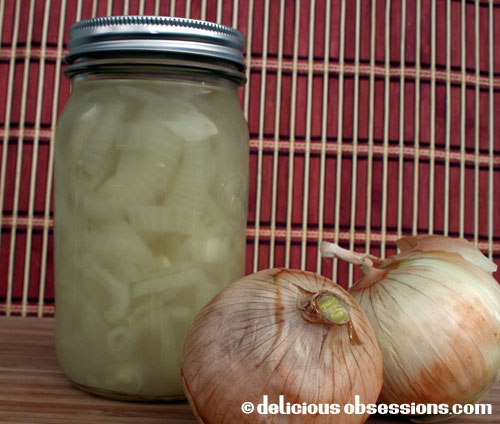FTC Disclosure: Delicious Obsessions may receive comissions from purchases made through links in this article. As an Amazon Associate I earn from qualifying purchases.Read our full terms and conditions here.
UPDATE 7/26/12: I no longer use whey as a starter for my ferments (learn why here). I also no longer use Mason jars for my ferments (learn why here). I use Fidos and Pickl-Its exclusively and the improvement in the taste and texture of my ferments is unbelievable! I encourage everyone to take a look at the information regarding Mason jar ferments and come to a decision that best fits their family. I will be releasing updated versions of these recipes soon, as it applies to the Fido and Pickl-It jars.
Hi All! I hope you have had a great weekend and are well rested for the upcoming week! Things have been insanely hectic around here, so I’ve just barely been keeping my head above water. I think things will start slowing down in the next few weeks, but for right now, I’m keeping the ferments simple and quick, so I apologize for not having anything new and earth shattering to share!
The Smelly, Yet Awesome, Onion
Simple and quick are exactly the words that can be used to describe this week’s ferment — pickled (lacto-fermented) onions. I don’t really think that I’ve made a ferment that is easier than this. Onions, salt, filtered water, and some brine from your fermented garlic (and/or whey if you’re using it).
Onions are a powerhouse of nutrition. They are similar to garlic in the nutrients that they provide. They are a great source of flavonoids, which are antioxidants that are sometimes referred to as Vitamin P. They are great immune boosters and have many medicinal properties. Because of the flavonoids, onions, as well as garlic, have long been known for their benefits to the cardiovascular system. Citrus fruits, berries, and parsley are other great sources of flavonoids. According to The Worlds’s Healthiest Foods website:
“The flavonoids in onion tend to be more concentrated in the outer layers of the flesh. To maximize your health benefits, peel off as little of the fleshy, edible portion as possible when removing the onion’s outermost paper layer. Even a small amount of “overpeeling” can result in unwanted loss of flavonoids. For example, a red onion can lose about 20% of its quercetin and almost 75% of its anthocyanins if it is “overpeeled.”
Onions also contain large levels of polyphenols. Polyphenols are a certain type of phytonutrient that actually include flavonoids. Onions have the highest polyphenol counts of most veggies, including garlic, leeks, carrots, tomatoes, and red peppers. There are only six vegetables that have been found to have higher counts than onions and those are artichokes, Brussels sprouts, shallots, celery, and broccoli.
The strong smell of onions means that they are rich in are the sulfur-contain compounds, which are important to the cardiovascular system. They help prevent the clotting and clumping of blood platelets. They have also been shown to help cholesterol and triglyceride levels, and even help strengthen the cell membranes of red blood cells. Some studies have shown that onions can even help increase bone density, again due to the sulfur compounds. Other studies have shown that eating onions several times a week can help lower your risk of some forms of cancer. That’s good news for people like me who eat onions pretty much every day. 🙂
Fermented onions are a great addition to all sorts of things. They taste great on burgers and hot dogs, as well as mixed into salads and salad dressings. If you can eat them raw, that will give you the best probiotic boost, but you can also use these to add rich onion flavor to soups, stews, and other heated dishes. I added some brine from one of my batches of pickled garlic, so that added enhanced the flavor and gave the ferment a little kick start. Red onions are going to have the highest levels of flavonoids, but I couldn’t find any for this batch, so I used Vidalia onions. I love Vidalias because they have such a sweetness to them that is only enhanced by the fermenting process.
Pickled (Lacto-Fermented) Onions
makes 1 quart
2-3 onions, thinly sliced
3 cups filtered water
1 tbsp. sea salt (mine is super fine grind)
3 tbsp. pickled garlic brine or whey (optional)
Slice the onions as thin as possible. Pack them into a clean, quart Mason jar (wide mouth works best). Add the salt and the brine from the pickled garlic (or whey), and then fill the rest of the way with the filtered water. Put a lid on tight and shake around until the salt is dissolved. Loosen the lid a little bit and leave at room temperature for 5-7 days. Move to cold storage. Will keep for a long time … if they last that long!
Sources: “Onions“, The World’s Healthiest Foods.


39 Comments